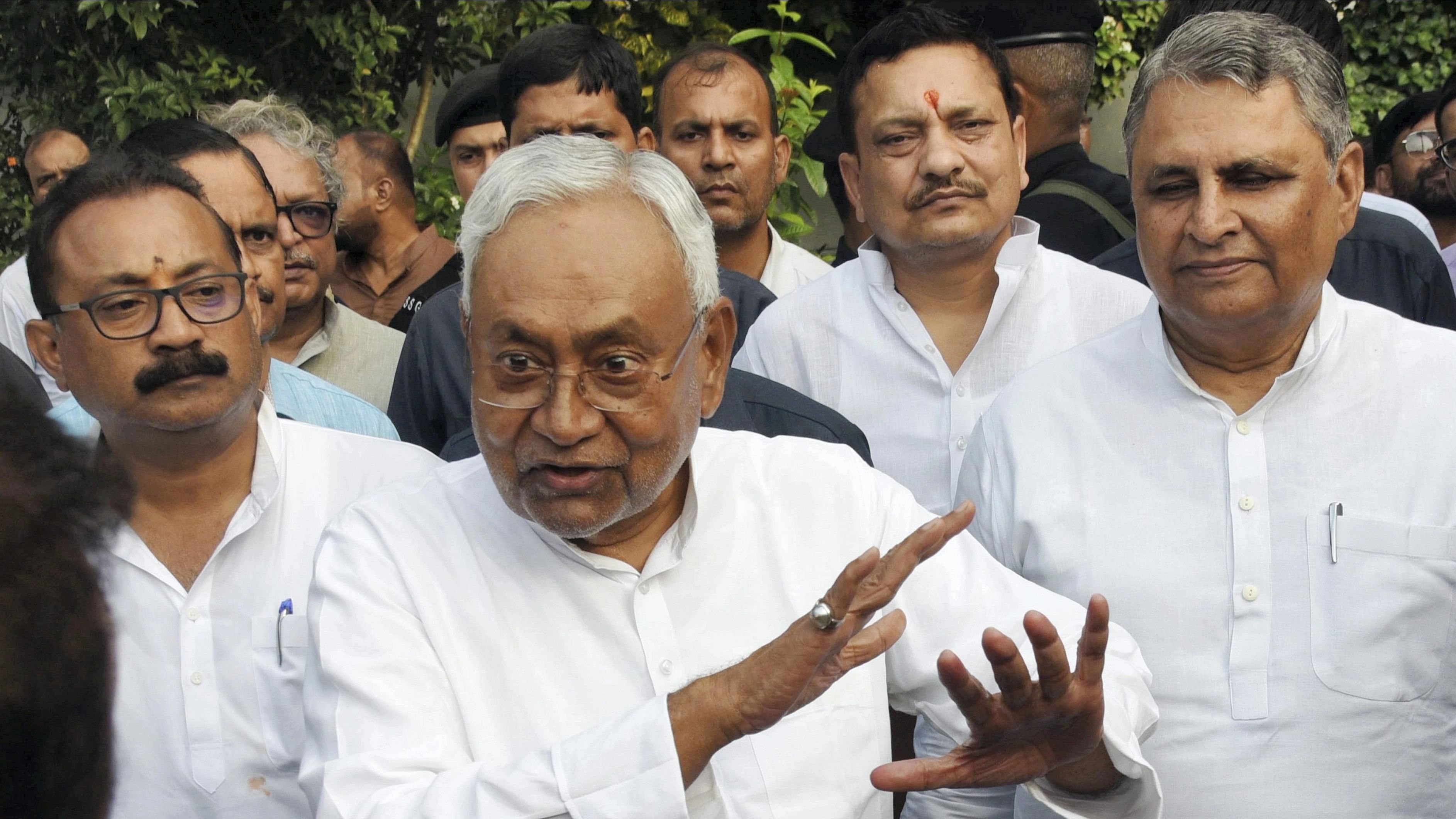
Bihar Chief Minister Nitish Kumar speaks with the media regarding the caste-based census report, earlier this year.
Credit: PTI File Photo
Patna: In the year preceding Lok Sabha elections, Bihar sought to trigger a second 'Mandal wave' with a fresh estimate of the high population of deprived castes, for whom quotas in government jobs and educational institutions were also increased.
The state also served as the ground on which 'opposition unity' germinated, with Chief Minister Nitish Kumar taking the initiative at the instance of West Bengal counterpart Mamata Banerjee, who held the view that the homeland of Jayaprakash Narayan should again take the lead in the battle against a domineering regime.
The government helmed by the JD(U) leader, the state's longest-serving chief minister, completed an ambitious caste survey, surmounting legal and political contestations.
Among other things, the survey revealed that those belonging to Other Backward Classes, including a subgroup called Extremely Backward Classes, who were never counted since the 1931 Census, accounted for a whopping 63 per cent of the total population.
Quotas for the aforementioned social groups, besides SCs and STs, were therefore raised from 50 per cent to 65 per cent, doing away with the Supreme Court cap on reservations.
Mindful of the resonance the move was likely to find with the electorate, the BJP, which draws its primary base from among the numerically small upper castes, chose not to challenge the entire exercise.
It confined its criticisms to 'inflated' numbers of Muslims, whom it has never been able to win over, and Yadavs, the most populous OBC group which remains unflinching in its loyalty to Lalu Prasad's RJD.
The ruling Mahagathbandhan in Bihar was, however, quick to point out that any suspected anomalies in the survey's findings could be ascertained and set right by a nationwide 'caste census' which only the Centre could undertake.
'Caste census' also became the buzzword beyond Bihar. The first resolution adopted by I.N.D.I.A promised that it would go for the exercise while the Congress promised Bihar-like surveys in a number of states.
Nitish Kumar, who had snapped ties with BJP, stripping it of power in Bihar, in 2022, seemed to be getting along well with his new allies, namely archrival Lalu Prasad's RJD, Congress and the Left.
His trusted aide Upendra Kushwaha, however, grew disillusioned after the JD(U) supremo appeared to be in a mood to pass on the mantle to current deputy Tejashwi Yadav, the son and heir apparent of the RJD chief.
Kushwaha, who merged his Rashtriya Lok Samata Party with the JD(U) a couple of years ago, quit the party, made yet another exit from the JD(U), floated a new outfit Rashtriya Loktantrik Janata Dal, and is now back in the NDA as an ally of which he had earlier enjoyed a stint in the Union council of ministers.
Another former associate who grew disenchanted with Kumar was Jitan Ram Manjhi, who heads Hindustani Awam Morcha, and had quit the NDA, ostensibly in solidarity with Kumar, saving his son Santosh Suman's cabinet berth in the bargain.
Manjhi panicked when Kumar asked him to merge HAM with JD(U), and after parting ways and joining NDA, he was trying to gain public sympathy out of the 'humiliation' he had received from the CM.
Despite being seen, in Bihar, as a champion of upper castes, the BJP took many steps to endear itself to OBCs and Dalits, a chunk of whom it must wean away to win the only Hindi-speaking state where it has, so far, never had its own chief minister.
The party's Dalit outreach has been evident in its tie-up with Manjhi and willingness to accommodate Pashupati Kumar Paras as also Chirag Paswan, both of whom are locked in a fierce fight to claim the legacy of the late Ram Vilas Paswan.
Its OBC card was seen in the truck with Kushwaha as also elevation of a relative newcomer, Samrat Choudhary, as the state president.
The subtle play of Hindutva was also seen in the party's outrage over the alleged cut in the number of holidays on 'Hindu festivals' in government school calendars.
Politics remained the most thriving business in the state which now hopes to step out of an economic rut with the promise of investments worth more than Rs 50,000 crore coming at an investors' meet held towards the year-end.
The Adani group has alone pledged investments worth Rs 8,700 crore, calling Bihar an 'attractive investment destination'.
While the private sector holds out the promise of its own share of employment generation in a state where joblessness has reached alarming proportions, the government got down to fulfilling the promise of job creation with a vengeance.
Massive recruitment drives were carried out in police, health and education departments.
Youngsters from even adjoining states like Uttar Pradesh turned up in large numbers to compete in exams held for selection of teachers.